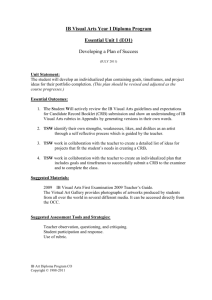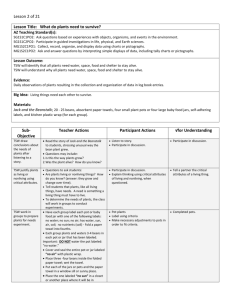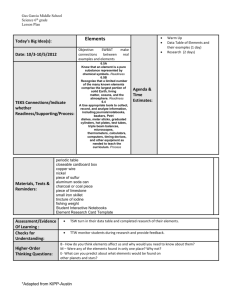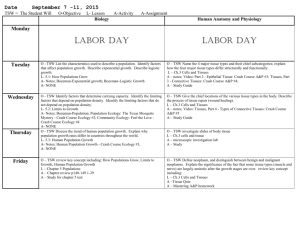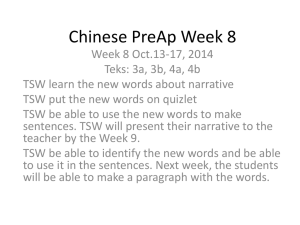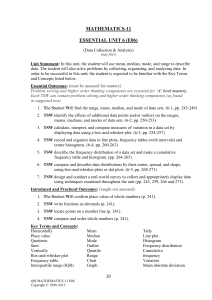12-13 EARTH SCI E06 11
advertisement
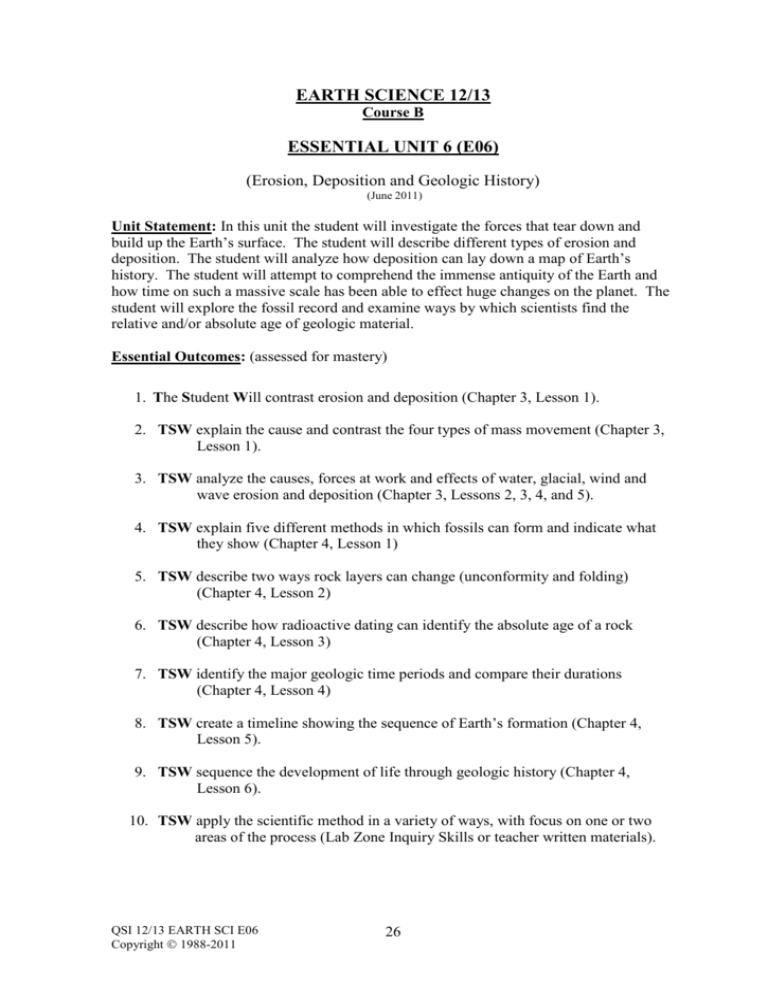
EARTH SCIENCE 12/13 Course B ESSENTIAL UNIT 6 (E06) (Erosion, Deposition and Geologic History) (June 2011) Unit Statement: In this unit the student will investigate the forces that tear down and build up the Earth’s surface. The student will describe different types of erosion and deposition. The student will analyze how deposition can lay down a map of Earth’s history. The student will attempt to comprehend the immense antiquity of the Earth and how time on such a massive scale has been able to effect huge changes on the planet. The student will explore the fossil record and examine ways by which scientists find the relative and/or absolute age of geologic material. Essential Outcomes: (assessed for mastery) 1. The Student Will contrast erosion and deposition (Chapter 3, Lesson 1). 2. TSW explain the cause and contrast the four types of mass movement (Chapter 3, Lesson 1). 3. TSW analyze the causes, forces at work and effects of water, glacial, wind and wave erosion and deposition (Chapter 3, Lessons 2, 3, 4, and 5). 4. TSW explain five different methods in which fossils can form and indicate what they show (Chapter 4, Lesson 1) 5. TSW describe two ways rock layers can change (unconformity and folding) (Chapter 4, Lesson 2) 6. TSW describe how radioactive dating can identify the absolute age of a rock (Chapter 4, Lesson 3) 7. TSW identify the major geologic time periods and compare their durations (Chapter 4, Lesson 4) 8. TSW create a timeline showing the sequence of Earth’s formation (Chapter 4, Lesson 5). 9. TSW sequence the development of life through geologic history (Chapter 4, Lesson 6). 10. TSW apply the scientific method in a variety of ways, with focus on one or two areas of the process (Lab Zone Inquiry Skills or teacher written materials). QSI 12/13 EARTH SCI E06 Copyright 1988-2011 26 Introduced & Practiced: 1. The Student Will explain how an element can be radioactive (Chapter 4, Lesson 2). 2. TSW contrast absolute and relative dating (Chapter 4, Lesson 3). 3. TSW create a mnemonic device that can be used to remember geologic eras and periods in their correct order (Chapter 4, Lesson 6). Key Terms: erosion sediment deposition gravity runoff gully tributary flood plain meander delta alluvial fam groundwater stalactite stalagmite glacier longshore drift spit deflation loess fossil mold cast evolution unconformity extinct relative age absolute age extrusion intrusion era period comet invertebrate vertebrate amphibian reptile mammal SUGGESTED RESOURCES & RUBRIC FOUND ON FOLLOWING PAGES…………… QSI 12/13 EARTH SCI E06 Copyright 1988-2011 27 Suggested Materials: Interactive Science, Earth’s Surface by Pearson, Chapters 3 and 4 Suggested Unit Resources: 1. Lab Zone; fully editable CD-Rom; Chapter Lab Investigations, Inquiry Warm-Ups, and Quick Labs (refer to Interactive Science – Earth’s Surface, page viii, and ix for a specific list of labs available for this unit). 2. Lab Zone Inquiry skills for each lesson as suggested in Interactive Science – Earth’s Structure, Contents, page viii and ix). 3. Study Guide & Review and Assessment for Interactive Science – Earth’s Surface Chapters 3 and 4. Technology Resources: 1. http://www.myscienceonline.com activities; The Big Question, Vocab Flash Cards, Interactive Art, Planet Diary, Virtual Lab, Untamed Science, My Science Coach, and My Reading Web. Use keywords ‘Erosion and Deposition,’ and ‘A Trip Through Geologic Time.’ 2. The Library’s online database – Destiny Webpath Express 3. http://www.unitedstreaming.com if your school has a membership. Suggested Assessment Tools and Strategies: 1. Any of the Inquiry skill activities you utilize from the text (TSWs 1-11) 2. Students create models to simulate the different types of erosion and deposition (TSW 3). 3. Students create simulated fossils (TSW 4). 4. Students create models to demonstrate understanding of unconformity and folding (TSW 5). 5. Students keep a journal of observations, ideas, and findings reflecting on reading, experiments, and class discussions (TSWs 1 - 9). 6. Students write a report, create a poster, and/or give a class presentation on any of the relevant topics (TSWs 1 - 9). 7. Teacher generated and/or published tests and assessments (TSWs 1 - 9). QSI 12/13 EARTH SCI E06 Copyright 1988-2011 28 TSW 1 – Erosion and deposition 2 – Mass movement Suggested Rubric for E06 ‘A’ Level Mastery ‘B’ Level Mastery The student contrasts erosion and deposition. The student is able to find real world examples of each of these types of mass movement and postulate the possible effects each could have on human settlements on or near the events. 3 – Types of erosion and deposition The student can explain the cause and contrast the four types of mass movement describing at least one way how each is different. The student is able to state the cause, effect and forces at work for water, glacial, wave, and wind erosion/deposition. 4 – Fossils The student can explain, in detail, the five methods of fossil formation. The student is able give simple explanations of how fossils can form and explain what a fossil shows. 5 – Folding and uncomform ity 6 –Radioactive dating The student diagrams folding and unconformity and includes an analysis of the forces at work for each. The student defines and illustrates folding and unconformity. The student is able to measure the age of different substances in text or teacher made scenarios. The student can explain how we can date radioactive material to fine the absolute age of rock. 7 – Geologic time periods 8 – Earth’s formation The student is able to compare the lengths of the different time periods. The student is able to list the different geologic time periods. 9 – Types of volcanoes The student is able to create a detailed diagram of the development of life and compare this diagram to the geologic time periods in TSW 7 and the timeline of Earth’s formation in TSW 8. The student is able to create a simple sequence timeline of the development of life on Earth. 10 – Scientific Method The student is able to analyze results, evaluate the validity of data, and pose additional questions and hypotheses based on conclusions of an experiment. The student responds to Lab Zone Inquiry Skills or teacher designed activities with reasonable responses. The student is able to create a timeline illustrating five major steps of the Earth’s formation. To receive an ‘A’, the student must show ‘A’ level mastery in at least 5 of the 7 available TSW’s and ‘B’ level mastery on all of the remaining TSW’s. To receive a ‘B’, the student must show ‘B’ level mastery on all nine TSW’s. QSI 12/13 EARTH SCI E06 Copyright 1988-2011 29



